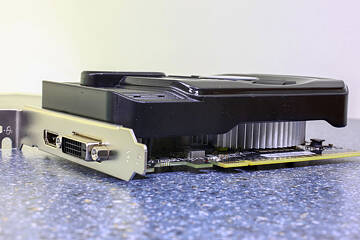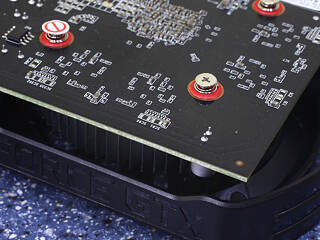Apr 5th, 2025 13:14 EDT
change timezone
Latest GPU Drivers
New Forum Posts
- RX 9000 series GPU Owners Club (172)
- Cpu getting locked at 4Ghz (3)
- I have a bricked XFX Radeon RX 580 8GB GPU. HELP! (4)
- Strange games on rtx 3070 ti and OCCT error too (0)
- Help me pick a UPS (70)
- New build advice (20)
- I7 9750h Thermal Throttling and Power Limit Issue (4)
- Mouse Stutter/CPU Throttling? (3)
- 5800x3D won't boost over 3.6Ghz? [SOLVED] (12)
- Will you buy a RTX 5090? (466)
Popular Reviews
- DDR5 CUDIMM Explained & Benched - The New Memory Standard
- PowerColor Radeon RX 9070 Hellhound Review
- Corsair RM750x Shift 750 W Review
- ASUS Prime X870-P Wi-Fi Review
- UPERFECT UStation Delta Max Review - Two Screens In One
- Sapphire Radeon RX 9070 XT Pulse Review
- Upcoming Hardware Launches 2025 (Updated Apr 2025)
- Pwnage Trinity CF Review
- Sapphire Radeon RX 9070 XT Nitro+ Review - Beating NVIDIA
- AMD Ryzen 7 9800X3D Review - The Best Gaming Processor
Controversial News Posts
- MSI Doesn't Plan Radeon RX 9000 Series GPUs, Skips AMD RDNA 4 Generation Entirely (146)
- Microsoft Introduces Copilot for Gaming (124)
- AMD Radeon RX 9070 XT Reportedly Outperforms RTX 5080 Through Undervolting (119)
- NVIDIA Reportedly Prepares GeForce RTX 5060 and RTX 5060 Ti Unveil Tomorrow (115)
- Over 200,000 Sold Radeon RX 9070 and RX 9070 XT GPUs? AMD Says No Number was Given (100)
- NVIDIA GeForce RTX 5050, RTX 5060, and RTX 5060 Ti Specifications Leak (97)
- Nintendo Switch 2 Launches June 5 at $449.99 with New Hardware and Games (90)
- Retailers Anticipate Increased Radeon RX 9070 Series Prices, After Initial Shipments of "MSRP" Models (90)
 32
32
Palit GeForce GTX 1650 StormX OC 4 GB Review
(32 Comments) »Introduction

Yesterday, NVIDIA announced the GeForce GTX 1650 graphics card, the smallest and most affordable implementation of the "Turing" architecture. Much like other GeForce GTX 16-series graphics cards launched to date, the GTX 1650 lacks dedicated RTX real-time raytracing hardware and tensor cores even though it is based on "Turing". NVIDIA is positioning the card at a starting price of US$149 and expects the card to be capable of Full HD (1080p) gaming with reasonably high settings.
The GeForce GTX 1650 is based on the tiny new "TU117" silicon from NVIDIA. This chip is configured with 896 CUDA cores, 56 TMUs, 32 ROPs, and a 128-bit wide GDDR5 memory interface holding 4 GB of memory that ticks at 8 Gbps, churning out 128 GB/s bandwidth. Not long ago, such specifications were considered quasi-premium for this price segment; that is, until AMD significantly cut prices of its Radeon "Polaris" graphics cards post the crypto-mining crash. The Radeon RX 570 4 GB, going by specifications alone, would qualify as a segment higher than the GTX 1650, but can be had for around the $130-mark from North American retailers.
With a rated power-draw of just 75 watts—half that of the RX 570—most GeForce GTX 1650 graphics cards typically do not need an additional PCIe power connector and can make do with slot power only, which can be useful when upgrading OEM systems that have weak PSUs and possibly lack the power cabling required for higher-end graphics cards. Certain premium factory-overclocked cards based on this chip may at best pack a single 6-pin connector. Display outputs typically only include one DisplayPort 1.4, HDMI 2.0b, and DVI-D each. The chip is endowed with all of the new 10bpc HDR video decoding hardware acceleration introduced with "Turing", so it has a solid resume for your living room.

In this review, we take a look at the Palit GeForce GTX 1650 StormX OC, the company's entry-level GTX 1650 offering with a simple and compact board design, a single fan-heatsink based cooling solution, and all the essentials of this SKU. Unlike other GTX 1650 cards we tested, the Palit GTX 1650 StormX does not have an additional 6-pin PCIe power connector and uses the default board power limit of 75 W—all of which is supplied through the PCI-Express x16 slot. This makes the card an interesting candidate to upgrade an older OEM computer that has a weak power supply or no 6-pin power cable available. As the name suggests, the GTX 1650 StormX OC is still overclocked to a rated boost frequency of 1725 MHz out of the box. Palit is pricing this card at the NVIDIA MRSP of $150.
| Price | Shader Units | ROPs | Core Clock | Boost Clock | Memory Clock | GPU | Transistors | Memory | |
|---|---|---|---|---|---|---|---|---|---|
| GTX 1050 | $130 | 640 | 32 | 1354 MHz | 1455 MHz | 1752 MHz | GP107 | 3300M | 2 GB, GDDR5, 128-bit |
| GTX 1050 Ti | $170 | 768 | 32 | 1290 MHz | 1392 MHz | 1752 MHz | GP107 | 3300M | 4 GB, GDDR5, 128-bit |
| GTX 1650 | $150 | 896 | 32 | 1485 MHz | 1665 MHz | 2000 MHz | TU117 | 4700M | 4 GB, GDDR5, 128-bit |
| Palit GTX 1650 StormX OC | $150 | 896 | 32 | 1485 MHz | 1725 MHz | 2000 MHz | TU117 | 4700M | 4 GB, GDDR5, 128-bit |
| RX 570 | $130 | 2048 | 32 | 1168 MHz | 1244 MHz | 1750 MHz | Ellesmere | 5700M | 4 GB, GDDR5, 256-bit |
| RX 580 | $190 | 2304 | 32 | 1257 MHz | 1340 MHz | 2000 MHz | Ellesmere | 5700M | 8 GB, GDDR5, 256-bit |
| GTX 1060 3 GB | $200 | 1152 | 48 | 1506 MHz | 1708 MHz | 2002 MHz | GP106 | 4400M | 3 GB, GDDR5, 192-bit |
| GTX 1060 | $200 | 1280 | 48 | 1506 MHz | 1708 MHz | 2002 MHz | GP106 | 4400M | 6 GB, GDDR5, 192-bit |
| RX 590 | $220 | 2304 | 32 | 1469 MHz | 1545 MHz | 2000 MHz | Polaris 30 | 5700M | 8 GB, GDDR5, 256-bit |
| GTX 1660 | $220 | 1408 | 48 | 1530 MHz | 1785 MHz | 2000 MHz | TU116 | 6600M | 6 GB, GDDR5, 192-bit |
| GTX 1070 | $300 | 1920 | 64 | 1506 MHz | 1683 MHz | 2002 MHz | GP104 | 7200M | 8 GB, GDDR5, 256-bit |
Packaging and Contents
You will receive:
- Graphics card
- Driver disc
- Documentation
The Card
The Palit GTX 1650 StormX is an extremely compact design—look at the size of the slot cover to get an idea of how small it is. Dimensions are 15.0 cm long and 10.0 cm high. A backplate is not included, which isn't surprising in this market segment.
Installation requires two slots in your system.
Display connectivity options include one HDMI 2.0b and one DVI port.
Since no DisplayPort is included, you won't be able to pair this graphics card with a VESA Adaptive Sync monitor. NVIDIA enabled support for FreeSync/Adaptive Sync earlier this year, but only for monitors connected via DisplayPort.
The board uses no additional power connector. This input configuration is specified for up to 75 watts of power draw.
GeForce GTX 1650 does not support SLI.
Disassembly
Palit's heatsink is really simple and cost efficient. It's basically a slab of metal with a fan strapped to it.
On the next page, we dive deep into the PCB layout and VRM configuration.
High-resolution PCB Pictures
These pictures are for the convenience of volt-modders and those who would like to see all the finer details on the PCB. Feel free to link back to us and use them in your articles or forum posts.High-res versions are also available (front, back).
Our Patreon Silver Supporters can read articles in single-page format.
Apr 5th, 2025 13:14 EDT
change timezone
Latest GPU Drivers
New Forum Posts
- RX 9000 series GPU Owners Club (172)
- Cpu getting locked at 4Ghz (3)
- I have a bricked XFX Radeon RX 580 8GB GPU. HELP! (4)
- Strange games on rtx 3070 ti and OCCT error too (0)
- Help me pick a UPS (70)
- New build advice (20)
- I7 9750h Thermal Throttling and Power Limit Issue (4)
- Mouse Stutter/CPU Throttling? (3)
- 5800x3D won't boost over 3.6Ghz? [SOLVED] (12)
- Will you buy a RTX 5090? (466)
Popular Reviews
- DDR5 CUDIMM Explained & Benched - The New Memory Standard
- PowerColor Radeon RX 9070 Hellhound Review
- Corsair RM750x Shift 750 W Review
- ASUS Prime X870-P Wi-Fi Review
- UPERFECT UStation Delta Max Review - Two Screens In One
- Sapphire Radeon RX 9070 XT Pulse Review
- Upcoming Hardware Launches 2025 (Updated Apr 2025)
- Pwnage Trinity CF Review
- Sapphire Radeon RX 9070 XT Nitro+ Review - Beating NVIDIA
- AMD Ryzen 7 9800X3D Review - The Best Gaming Processor
Controversial News Posts
- MSI Doesn't Plan Radeon RX 9000 Series GPUs, Skips AMD RDNA 4 Generation Entirely (146)
- Microsoft Introduces Copilot for Gaming (124)
- AMD Radeon RX 9070 XT Reportedly Outperforms RTX 5080 Through Undervolting (119)
- NVIDIA Reportedly Prepares GeForce RTX 5060 and RTX 5060 Ti Unveil Tomorrow (115)
- Over 200,000 Sold Radeon RX 9070 and RX 9070 XT GPUs? AMD Says No Number was Given (100)
- NVIDIA GeForce RTX 5050, RTX 5060, and RTX 5060 Ti Specifications Leak (97)
- Nintendo Switch 2 Launches June 5 at $449.99 with New Hardware and Games (90)
- Retailers Anticipate Increased Radeon RX 9070 Series Prices, After Initial Shipments of "MSRP" Models (90)












